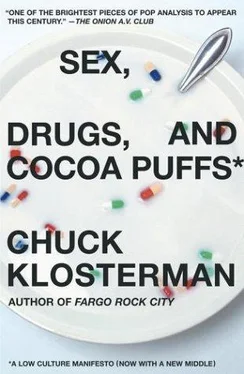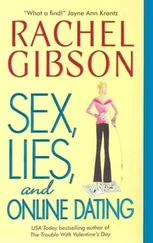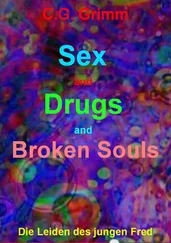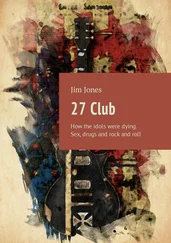An even sadder illustration of cereal segregation is Sonny the Cuckoo Bird, arguably the most tortured member of the advertising community. Sonny is plagued with self-loathing; though outspokenly otaku for Cocoa Puffs, he doesn’t feel he deserves to consume them. Sonny will do anything to escape from his jones, including (but not limited to) locking himself into a primitive skycycle and shooting himself into outer space. To make matters worse, he is bombarded by temptation: Random children endlessly taunt him with heaping bowls of C-Puffs, almost like street junkies waving heroin needles in the face of William S. Burroughs. The kids have cereal, and Sonny does not. Translation: The kids are cool, and Sonny’s an extremist and a failure. And as long as they possess what he does not, Sonny shall remain a second-class phoenix, doomed by his own maniacal ambition for breakfast.
Commercials for Lucky Charms star a leprechaun who replaced the pot of gold at the end of the rainbow with a bowl of marshmallow-laden cereal, a narrative device that slightly overstated the value of the actual product. The Cookie Crisp [46] 2. This is not to be confused with the short-lived Oatmeal Cookie Crisp, a cereal fronted by the good-natured wizard “Cookie Jarvis.”
mascot was a masked rapscallion named “Crook,” whose whole self-identity was built on stealing cereal. In ads for both Cocoa and Fruity Pebbles, Barney Rubble went to ridiculous lengths in the hope of shoplifting Fred Flintstone’s breakfast, occasionally dressing like a woman and/or rapping like Ghostface Killah. Time and time again, commercials for cereal assault children with the same theme: A product’s exclusivity is directly proportional to its social cachet, which is the definition of calculated adult coolness.
When I say calculated adult coolness, I’m referring to the kind of coolness that generally applies to people between the ages of nineteen and thirty-six. This is different than mainstream teen coolness and aging hipster default coolness, both of which reflect an opposing (and sort of pathetic) consumer aesthetic. Cereal ads are directed at kids, but they barely work on young people; the kind of advertising that works on a teenager are bandwagon spots for things like Trident and khaki Gap pants. Those ads imply that these are products everybody else already owns. Teenagers claim they want to be cool, but they mostly just want to avoid being uncool. It’s the same for aging hipsters, an equally terrified class of Americans who slowly conclude that the key to staying relevant is by exhibiting default appreciation for the most obvious youth culture entities; this is why you often hear forty-seven-year-old men with ponytails saying things like, “Oh, I’m totally into the new stuff. That new Nickelback record is just terrific.” Aging hipsters and corduroy-clad high school sophomores are both primarily concerned with dodging lameness. However, there is a stretch in everyone’s early adulthood where they can choose (or choose against) creating their own personalized version of nonpopulist cool, which may (or may not) succeed. This is accomplished by embracing semioriginal, semielitist cultural artifacts that remain just out of reach to those who desire them—the so-called “Cocoa Puffs of Power.”
We all relate to Sonny the Cuckoo Bird. We pursue that which retreats from us, and coolness is always a bear market. Coolness is always what others seem to have naturally—an unspecific, delicious, chocolately paradigm we must pilfer through subterfuge. It drives us, for lack of a better term, coo coo. And part of the reason we struggle is because there is no hard-and-fast clarity about what qualifies anything as cool . It needs to be original, but only semioriginal: It would be legitimately inventive (and kind of “out there”) to casually walk around with the petrified skull of a orangutan under your arm for no obvious reason, but this would only seem cool to a select class of performance artist. A better choice would be a T-shirt featuring the cast of After M*A*S*H . A cool image also needs to be semielitist, but it can’t be wholly elitist: What you display should be extremely hard to find, yet could have been theoretically found by absolutely anyone six months ago (had they possessed the foresight). This is why calculated adult coolness would reward the possession of, say, a can of Elf soda pop, yet frown upon the possession of, say, four ounces of weapons-grade uranium. [47] 3. Although this would make you very cool in Syria.
The impact of this understanding comes later in life, usually at college, and usually around the point when being “weird” starts to be periodically interpreted by others as “charming” and/or “sexually intriguing.” As noted earlier, kids don’t really understand the nuance of cereal advertising until they reach their twenties; this is when characters like the Trix Rabbit evolve into understated Christ figures. And though the plot is not purposeful on the behalf of cereal makers, it’s also not accidental. Cereal mascots are generally associated with sugared cereals—while a box of Wheaties might feature anyone from Bruce Jenner to Michelle Kwan, Count Chocula sticks with its mischievous vampire. Super Golden Crisp sells itself with the portrait of a laid-back bear wearing a mock turtleneck; Grape Nuts sells itself with a photograph of Grape Nuts. And this is more proof of cereal’s overlooked relationship to American cool: Being cool is mostly ridiculous, and so is sugared cereal. That’s why we like it.
I eat sugared cereal almost exclusively. This is because I’m the opposite of a “no-nonsense” guy. I’m an “all-nonsense” guy. Every time I drive a long distance, I’m hounded by the fear that I will get a flat tire and be unable to change it. When a button falls off one of my dress shirts, I immediately throw away the entire garment and buy a new one. I can’t swim; to me, twelve feet of water is no different than twelve feet of hydrochloric acid (it will kill me just as dead). However, I can stay awake for seventy-two straight hours. I can immediately memorize phone numbers without writing them down. When flipping channels during commercial breaks in televised sporting events, I can innately sense the perfect moment to return to what I was watching originally. So the rub is that I have these semicritical flaws and I have these weirdly specific gifts, and it seems like most Americans are similarly polarized by what they can (and cannot) do. There are no-nonsense people, and there are nonsense people. And it’s been my experience that nonsense people tend to consume Cocoa Krispies and Lucky Charms and Cap’n Crunch ( “nonsense food,” if you will). Consequently, we nonsense types spend hours and hours staring at cardboard creatures like the Trix Rabbit and absorbing his ethos, slowly ingesting the principles of exclusionary coolness while rapidly ingesting sugar-saturated spoonfuls of Vitamin B-12.
The desire to be cool is—ultimately—the desire to be rescued. It’s the desire to be pulled from the unwashed masses of society. It’s the desire to be advanced beyond the faceless humanoid robots who will die unheralded deaths and never truly matter, mostly because they all lived the same pedestrian life. Without the spoils of exclusionary coolness, we’re just cogs in the struggle. We’re like a little kid trying to kayak (or perhaps freestyle rock climb), and all the older kids keep mocking our efforts, openly implying that we cannot compete. But if we can just find that one cool thing that nobody else has—that gregarious, nine-foot animated jungle cat who can provide a glimmer of hope and a balanced breakfast—we can be better than ourselves. We can be tigers . ’Atta boy.
Читать дальше












